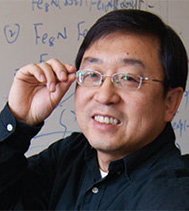Jian-Ping Wang

Jian-Ping Wang is a Distinguished McKnight University Professor of Electrical and Computer Engineering, and a member of the graduate faculty in Physics, Chemical Engineering and Materials Science and Biomedical Engineering at the University of Minnesota. He received his PhD degree in 1995 from Institute of Physics, Chinese Academy of Sciences, where he performed research on nanomagnetism. He established and managed the Magnetic Media and Materials program at Data Storage Institute, Singapore, as the founding program manager, from 1998 to 2002. He joined the faculty of the Electrical and Computer Engineering department at the University of Minnesota in 2002 and was promoted to full professor in 2009. He is the associate director of the Center for Micromagnetics and Information Technologies (MINT) at the University of Minnesota. He received the information storage industry consortium (INSIC) technical award in 2006 for his pioneering work in exchange coupled composite magnetic media and the outstanding professor award for his contribution to undergraduate teaching in 2010. He has authored and co-authored more than 210 publications in peer-reviewed top journals and conference proceedings and holds 17 patents. He has been performing pioneering research on exchange coupled composite perpendicular media, perpendicular spintronic devices and magnetic tunnel junction based memory, logic and computation devices. His current research programs focus on searching, fabricating and fundamentally understanding novel nanoscale magnetic and spintronic materials and devices.
| 1. | H. Meng, J. Wang, and J. P. Wang, “A Spintronics Full Adder for Magnetic CPU”, IEEE ELECTRON DEVICE LETTERS, 26, 360 (2005). |
| 2. | H. Meng, and J. P. Wang, “Spin Transfer in Nanomagnetic Devices with Perpendicular Anisotropy,” APPLIED PHYSICS LETTERS 88, 172506 (2006). |
| 3. | Y.F. Ding, J. Judy and J. P. Wang, “Magnetic Read Sensor with Perpendicular Anisotropy”, IEEE TRANSACTIONS ON MAGNETICS, 41, 707 (2005). |
| 4. | H. Meng, and J. P. Wang, “Composite Free Layer for High Density Magnetic Random Access Memory with Lower Spin Transfer Current,” APPLIED PHYSICS LETTERS 89, 152509 (2006). |
| 5. | J.P Wang and X. F. Yao, “Programmable Spintronic Logic Devices for Reconfigurable Computation and Byeond- History and outlook”, Special issue in Spintronics, JOURNAL OF NANOELECTRONICS AND OPTOELECTRONICS 3, 12 (2008). |
| 6. | A. Lyle, J. Harms, S. Patil, Y. F. Yao, D. Lilja and J. P. Wang, “Direct Communication between Magnetic Tunnel Junctions for Nonvolatile Logic Fan-out Architecture”, APPLIED PHYSICS LETTERS 97 (23): 152504 (2010). |
| 7. | N. Ji, M. Osofsky, V. Lauter, L. F. Allard, H. Ambaye, E. Lara-Curzio, X. Li, K. Jensen and J. P. Wang, “Perpendicular Magnetic Anisotropy and High Spin Polarization Ratio in Epitaxial Fe-N Thin Films”, PHYSICAL REVIEW B, 84, 245310 (2011). |
| 8. | M.T. Rahman; A. Lyle; G. Hu; W. J. Gallagher and J. P. Wang, “High Temperature Annealing Stability of Magnetic Properties in MgO-based Perpendicular Magnetic Tunnel Junction Stacks with CoFeB Polarizing Layer”, JOURNAL OF APPLIED PHYSICS, 109, 07C709 (2011). |
| 9. | X. Yao, J. Harms, A. Lyle, F. Ebrahimi, Y. Zhang and J. P. Wang, “Magnetic Tunnel Junction-Based Spintronic Logic Units Operated by Spin Transfer Torque”, IEEE TRANSACTION ON NANOTECHNOLOGY, 11, 120 (2012). |
| 10. | A. Lyle, J. Harms, T. Klein, A. Lentsch, A. Klemm, D. Martens and J. P. Wang, “Integration of Spintronic Interface for Nanomagnetic Arrays”, AIP ADVANCE, 1, 042177 (2011). |
| 11. | H. Zhao, B. Glass, P.K. Amiri, A. Lyle, Y. Zhang, Y.J. Chen, P. Upadhyaya, G.E. Rowlands, Z. M. Zeng, J. A. Katine, J. Langer, H. W. Jiang, K. Galatsis, K. L. Wang, I. N. Krivorotov, and J. P. Wang, “Sub 200ps Spin Transfer Torque Switching in CoFeB-MgO Magnetic Tunnel Junctions under Zero Bias Field,” J. Phys. D 45, 025001 (2012). |
| 12. | Y. Jiang, J. D. Harms and J. P. Wang, “Magnetic Tunnel Junction-Based Spin Register for Nonvolatile Integrated Circuits”, IEEE Transactions on Electron Devices, 59, 2917 (2012). |


